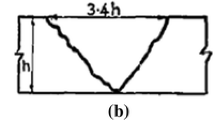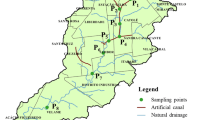Summary
This article describes a vulnerability assessment based on the spatial sensitivity analysis, as part of the "Achilles Approach" for reliable operation of combined sewer systems. A selection of thematic maps for combined sewer systems (sewer collapse, failure of combined sewer overflows or pump failure) is presented and their application demonstrated using three case studies - Götzis, Hall in Tyrol and Innsbruck. It is shown how these thematic maps can be used for planning proactive actions. It is also demonstrated how causal linking of failure of combined sewer overflows and pump station (cascading failure) can be investigated systematically to support an efficient planning of preventive measures such as redundant pumps stations or installation of an emergency power supply. In addition, a capacity map identifying the most effective sites for new storage volumes is presented as "positive" interpretation of such a sensitivity map. This thematic map supports the planning process and ensures the efficient use of resources.
Zusammenfassung
In dieser Arbeit wird die Schwachstellenanalyse basierend auf der örtlichen Sensitivitätsanalyse im Rahmen des "Achilles-Ansatzes" für eine sichere Bewirtschaftung von Mischwasseranlagen präsentiert. Es wird eine Auswahl von im "Achilles-Ansatz" entwickelten Themenkarten für Mischsysteme (Haltungseinsturz, Entlastungsausfall, Pumpwerksausfall) vorgestellt und deren Anwendung mit den drei Fallstudien Götzis, Hall in Tirol und Innsbruck demonstriert. Dabei wird aufgezeigt, wie die erstellten Themenkarten für die Planung von Präventivmaßnahmen gegen Störfälle verwendet werden können. Zusätzlich wird gezeigt wie eine kausal abhängige Verkettung von Haltungs- und Pumpwerksausfällen (Kaskadenausfall) systematisch untersucht werden kann, und somit das effiziente Planen von Präventivmaßnahmen wie redundante Pumpwerke oder die Installation von Notstromaggregaten unterstützt werden kann. Als "positive" Interpretationsmöglichkeit der Sensitivitätskarten wird die Kapazitätenkarte vorgestellt, mit der die effektivsten Positionen für neu errichtete Mischwasserrückhaltebecken identifiziert werden können. Diese Themenkarte unterstützt den Planungsprozess und gewährleistet einen effizienten Ressourceneinsatz.
Similar content being viewed by others
Literatur
DWA A 118 (2006): Hydraulische Bemessung und Nachweis von Entwässerungssystemen. DWA e.V., Hennef
Fritsch E. (2010). Kritische Infrastruktur in der Siedlungswasserwirtschaft - Planung. Risikomanagement und Vorsorge für kritische Wasserinfrastrukturen, 27. Jänner 2010, Innsbruck, Österreich
Mair M., Sitzenfrei R., Kleidorfer M., Moderl M. and Rauch W. (im Druck). GIS-based applications of sensitivity analysis for sewer models. Water science and technology
Möderl M., Hellbach C., Sitzenfrei R., Mair M., Lukas A., Mayr E., Perfler R. and Rauch W. (2011). GIS Based Applications of Sensitivity Analysis for Water Distribution Models. ASCE Conf. Proc. doi: http://dx.doi.org/10.1061/41173(414)14 Procecdings of the 2011 World Environment and Water Resources
Möderl M., Sitzenfrei R. and Rauch W. (2010). Achilles Approach to Identify Vulnerabilities in Urban Water Infrastructure for Operation and Emergency Management. IWA World Water Congress and Exhibition, 19 - 24 Sept. 2010, Montreal, Canada
Möderl M., Lammel J., Apperl M. and Rauch W. (2011). Entwässerungssicherheitspläne (ESP). DVGW energie | wasserpraxis
ÖNORM EN 752 (2008): Entwässerungssysteme außerhalb von Gebäuden. Österreichisches Normungsinstitut, Wien
ÖWAV-RB 19 (2007): Richtlinie für die Bemessung von Mischwasserentlastungen. Österreichischer Wasser- und Abfallwirtschaftsverband, Wien
ÖWAV RB 11 (2009): Richtlinie für die abwassertechnische Berechnung und Dimensionierung von Abwasserkanälen. Österreichischer Wasser- und Abwasserverband, Wien
Rauch W., Kleidorfer M. and Fach S. (2010). Vom Bleistift zum Prozessor: Wandel der Modelle in der Siedlungsentwässerung (From the pencil to the processor: Change in the modelling of urban sewerage systems). Österreichische Wasser- und Abfallwirtschaft, 62 (3-4), 43–50
Rossman L. A. (2004). Storm water management model - User's manual Version 5.0. National Risk Management Research Laboratory - U.S. Environmental Protection Agency, Cincinnati, Ohio
Sitzenfrei R., Mair M., Möderl M. and Rauch W. (2011). Cascade vulnerability for risk analysis of water infrastructure. Water Science and Technology 64 (9), 1885–1891
Author information
Authors and Affiliations
Corresponding authors
Rights and permissions
About this article
Cite this article
Sitzenfrei, R., Möderl, M., Fritsch, E. et al. Schwachstellenanalyse bei Mischwasseranlagen für eine sichere Bewirtschaftung. Österr Wasser- und Abfallw 64, 293–299 (2012). https://doi.org/10.1007/s00506-012-0372-4
Issue Date:
DOI: https://doi.org/10.1007/s00506-012-0372-4




